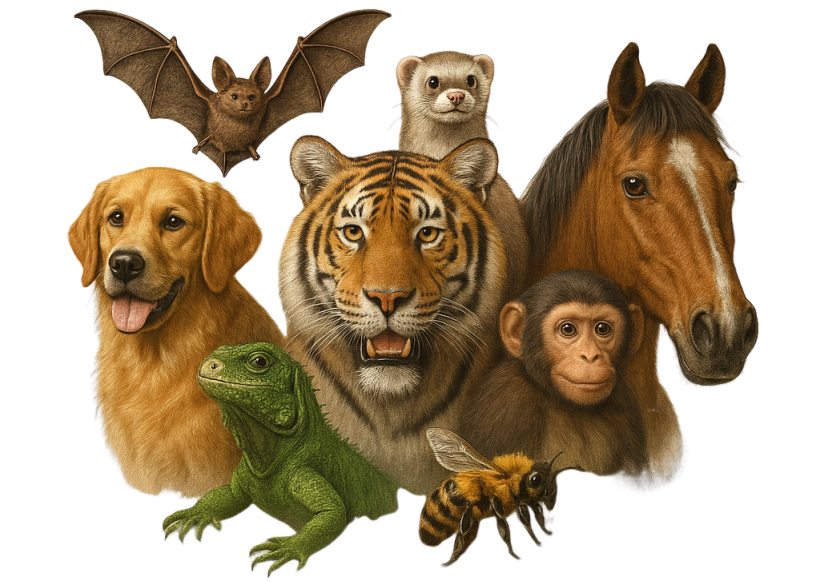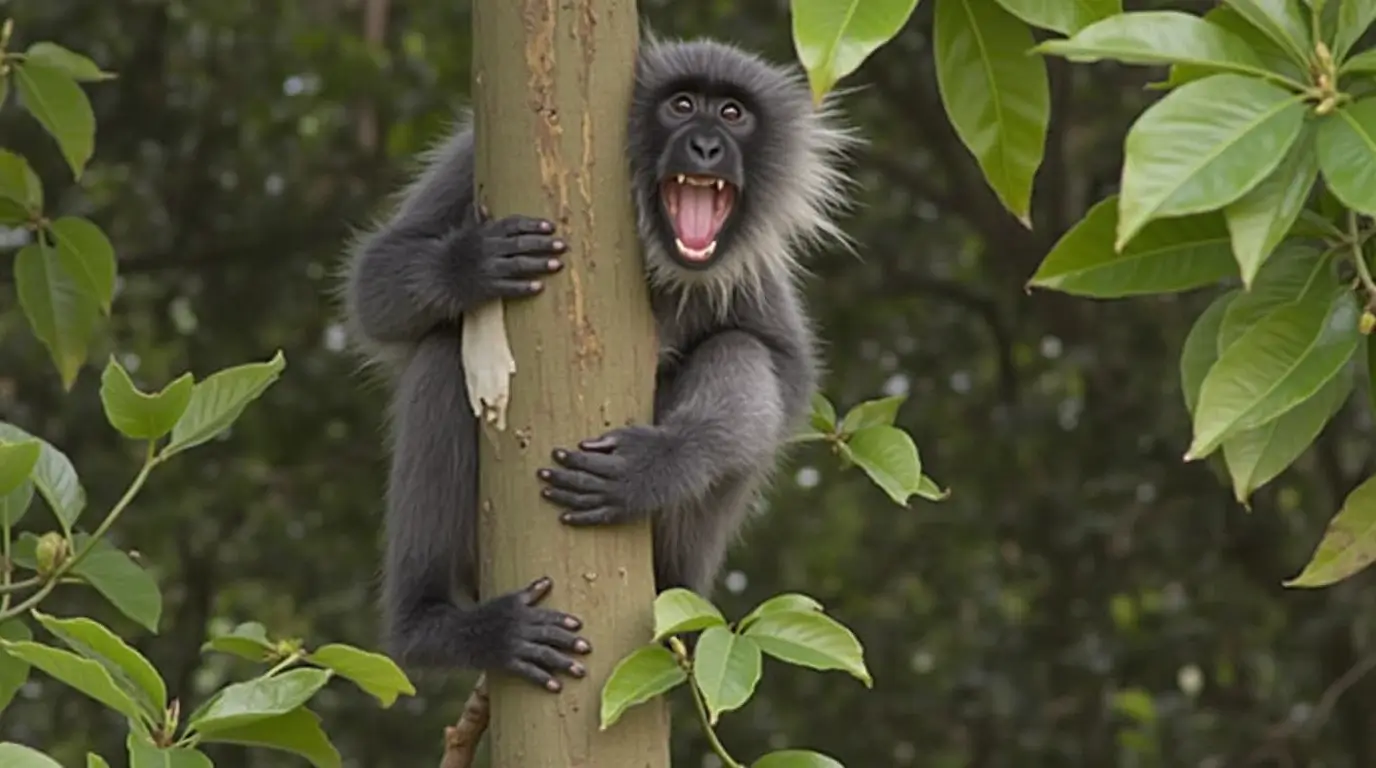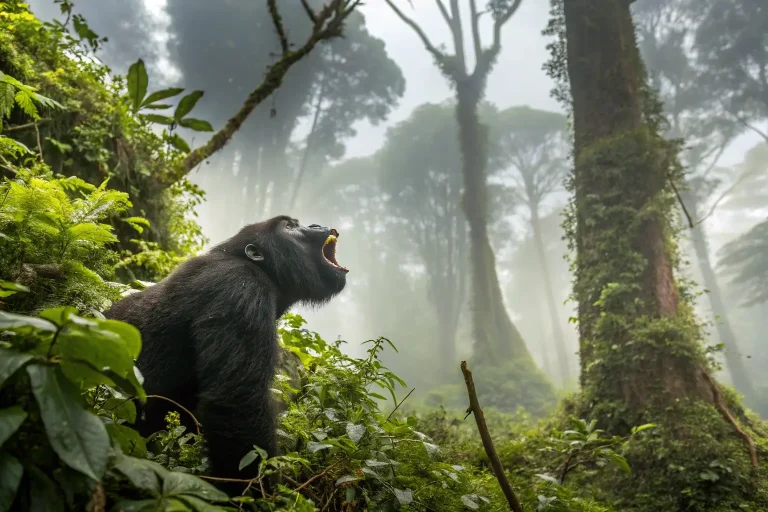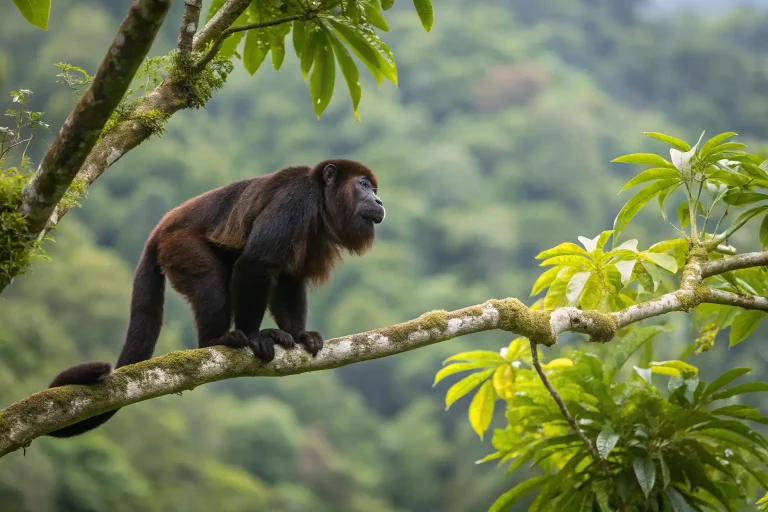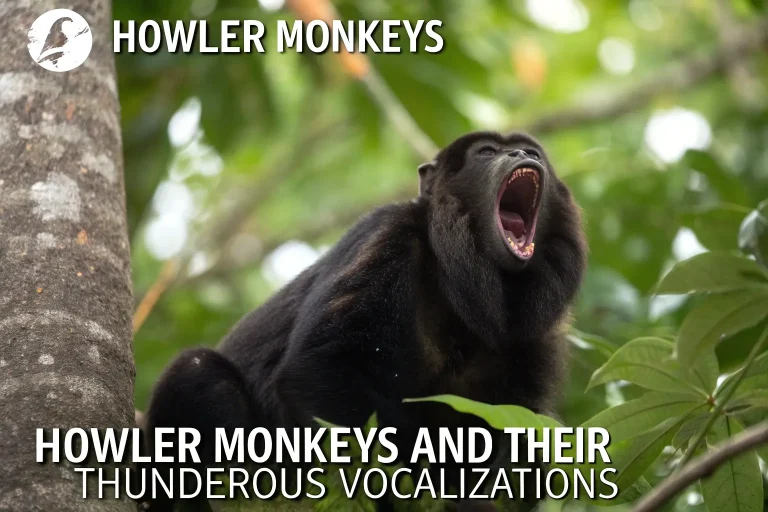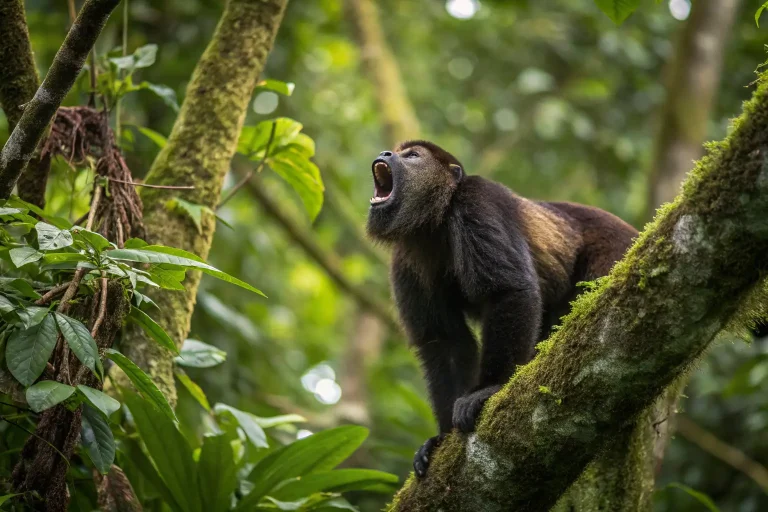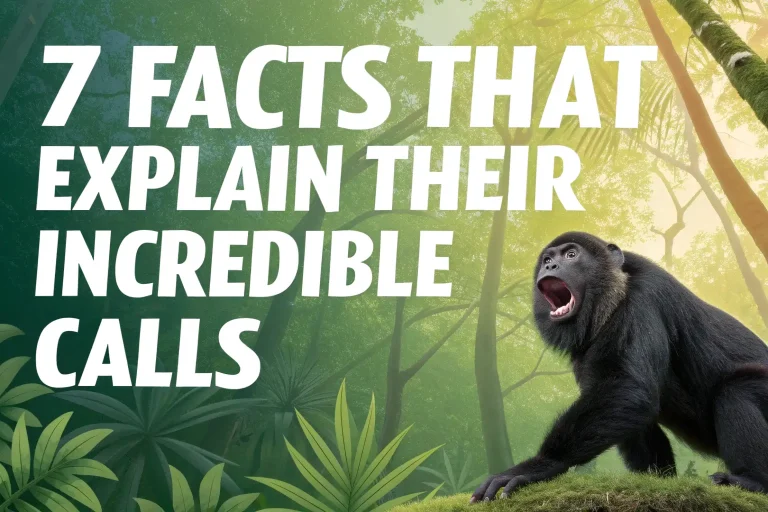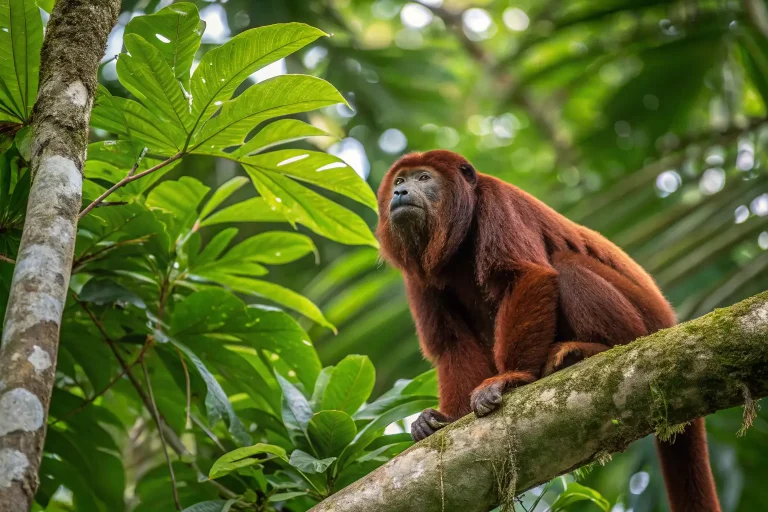Howler Monkey Howling Sound: 7 Fascinating Facts You’ll Want To Hear
Introduction
Deep within the lush canopies of Central and South American rainforests, an extraordinary sound echoes through the trees – the unmistakable howler monkey howling sound. This remarkable vocalization can travel for miles, cutting through dense jungle foliage and announcing the presence of one of nature’s most vocal creatures.
The howler monkey howling sound isn’t just impressive; it’s legendary. In fact, these primates hold the title of the loudest land animals in the Western Hemisphere, with calls that can be heard up to three miles away through dense forest. Their powerful vocal demonstrations serve as both territorial announcements and complex social communications.
Whether you’ve heard this primal call in person during a rainforest expedition or simply stumbled across viral videos of these vocal primates, there’s something about the howler monkey’s call that captivates our imagination and connects us to our evolutionary past. As we explore these remarkable creatures, you’ll discover surprising facts about their sonic abilities that few people realize.
Species Overview
Scientific Classification
Howler monkeys belong to the genus Alouatta within the family Atelidae. There are currently nine recognized species of howler monkeys, including:
- Mantled howler (Alouatta palliata)
- Black howler (Alouatta caraya)
- Red howler (Alouatta seniculus)
- Venezuelan red howler (Alouatta arctoidea)
- Brown howler (Alouatta guariba)
- Guatemalan black howler (Alouatta pigra)
- Coiba Island howler (Alouatta coibensis)
- Mexican howler (Alouatta mexicana)
- Maranhão red-handed howler (Alouatta ululata)
Physical Characteristics
What makes the howler monkey howling sound so powerful is directly related to the animal’s unique physical characteristics. Howler monkeys are medium to large primates, typically weighing between 10-22 pounds (4.5-10 kg), with males generally larger than females. Their body length ranges from 22-36 inches (56-92 cm), not including their strong prehensile tails which add another 23-36 inches (58-91 cm).
Perhaps their most distinctive feature is their specialized hyoid bone – an enlarged, hollow bone in the throat that functions as a resonating chamber. This evolutionary adaptation gives the howler monkey its characteristic deep, guttural howling sound. The hyoid bone in male howlers is particularly enlarged, explaining why their calls are typically louder and deeper than females.
Howlers also possess a distinctive beard-like appearance, with facial features that vary from species to species. Their fur color ranges dramatically across species, from entirely black to reddish-brown, golden, or a mix of colors. Such diversity helps researchers identify different species in the wild, along with their distinctive howler monkey howling sound patterns.
Subspecies and Regional Variations
Research has identified several subspecies within the main howler monkey species, each with subtle variations in their howls. For instance, the mantled howler (Alouatta palliata) has three recognized subspecies:
- Alouatta palliata palliata – inhabiting southern Mexico to central Costa Rica
- Alouatta palliata mexicana – found in southeastern Mexico and Guatemala
- Alouatta palliata aequatorialis – living in western Colombia and Ecuador
Interestingly, acoustic analysis reveals that the howler monkey howling sound differs slightly between these subspecies, with variations in pitch, duration, and pattern. These subtle distinctions help primatologists identify population groups and study their distribution patterns across regions.
Habitat and Distribution
Natural Habitat
Howler monkeys thrive in the upper canopy of tropical and subtropical forests, rarely descending to the ground. They prefer humid, dense forests with tall trees that provide both food sources and protection from predators. The acoustics of these forests actually enhance the howler monkey howling sound, allowing it to travel further through the canopy.
Within their forest habitat, howlers construct leafy nests and rest spots high in the trees, typically 40-160 feet (12-49 meters) above the ground. This elevated lifestyle keeps them safe from many ground predators and positions them perfectly to project their distinctive howls across their territory.
Geographic Range
The geographic distribution of howler monkeys spans from southern Mexico through Central America and into South America, including Brazil, Bolivia, Paraguay, and northern Argentina. Different species occupy specific regions within this range:
- Black howlers inhabit central Brazil, Paraguay, and northern Argentina
- Red howlers are found in Colombia, Venezuela, and parts of Brazil
- Mantled howlers range from Mexico through Central America to Ecuador and Colombia
This broad distribution means the howler monkey howling sound echoes through diverse ecosystems, from lowland rainforests to cloud forests and even semi-deciduous forests at higher elevations.
Adaptations
Howler monkeys have developed remarkable adaptations for their arboreal lifestyle, beyond just their vocal abilities. Their prehensile tails function as a “fifth limb,” allowing them to hang securely while feeding and moving through trees. This adaptation is crucial for spending nearly their entire lives in the canopy.
Their digestive systems have evolved to process a primarily folivorous (leaf-eating) diet, including specialized bacteria that help break down cellulose. This adaptation allows them to survive on food sources that other primates cannot digest efficiently.
However, their most famous adaptation relates to their incredible vocalizations. The howler monkey howling sound serves multiple ecological purposes:
- Territorial defense without physical confrontation
- Coordination of group movements through dense forests
- Mate attraction during breeding seasons
- Warning signals about potential predators
These adaptations collectively allow howler monkeys to thrive in their forest habitats while minimizing energy expenditure – a critical factor for animals with restrictive, low-energy diets.
Diet and Feeding Habits
What They Eat
Howler monkeys follow a primarily herbivorous diet, with leaves constituting about 70% of their food intake. They prefer young, tender leaves that contain fewer toxins and are easier to digest. They supplement this leaf-heavy diet with:
- Fruits (especially during seasonal abundance)
- Flowers
- Buds
- Seeds
- Nuts
- Occasional insects
This specialized diet directly impacts the howler monkey howling sound production since their low-energy food sources require them to conserve energy whenever possible. Their famous howls allow them to defend territory and communicate without the energetic costs of physical confrontation.
Foraging Behavior
Howlers typically feed in the early morning and late afternoon, spending 4-5 hours per day actively foraging. They move methodically through their territory, following established routes through the canopy that connect known food sources. During midday, when temperatures rise, they often rest and digest their fibrous meals.
Interestingly, researchers have documented how howler monkey troops coordinate movements through vocalizations. The distinctive howler monkey howling sound often precedes group movement to new feeding areas, suggesting these calls serve not just as territorial markers but as complex social coordination signals.
Dietary Needs
A howler monkey’s specialized digestive system includes an enlarged cecum (a pouch at the beginning of the large intestine) housing beneficial bacteria that break down cellulose in leaves. This adaptation allows them to extract maximum nutrition from fibrous plant material.
Their relatively slow metabolism and tendency toward energy conservation align perfectly with their low-calorie diet. Adult howlers typically consume 1.5-2 pounds (0.7-0.9 kg) of vegetation daily, which provides just enough energy for their needs.
During pregnancy and nursing, female howlers increase their consumption, particularly seeking protein-rich young leaves. This increased nutritional need corresponds with changes in movement patterns and sometimes an increased frequency of group howling sessions.
Behavior and Social Structure
Social Behavior
Howler monkeys live in social groups typically consisting of 10-20 individuals, though group size varies by species and habitat conditions. These groups usually contain 1-3 adult males, several adult females, and their offspring. The social dynamics directly influence the howler monkey howling sound patterns, as dominant males often lead choruses.
Within these groups, researchers have observed clear hierarchies, with dominant males gaining preferential access to food resources and mating opportunities. However, female howlers also establish their own hierarchies independent of the males.
Unlike some primate species that engage in extensive grooming behaviors, howlers spend relatively little time in physical social bonding. Instead, their group cohesion appears to be maintained through their vocalizations and coordinated activities like feeding and resting.
Communication
The howler monkey howling sound represents just one component of their complex communication system. Their vocal repertoire includes:
- Dawn chorus howls (territorial announcements)
- Inter-group howling contests (boundary maintenance)
- Alarm calls (warning of predators)
- Contact calls (maintaining group cohesion)
- Mating calls (reproduction-related)
These vocalizations vary in pitch, duration, and pattern. Males produce the loudest calls, reaching an incredible 140 decibels – comparable to a jet engine at takeoff. Recent research has revealed that female howlers also participate in group howling sessions, though their contributions are typically higher-pitched and less powerful.
Beyond vocalizations, howler monkeys communicate through body postures, facial expressions, and scent marking. These multi-modal communication channels help maintain group cohesion even when visual contact is limited in dense forest canopies.
Mating and Reproduction
Howler monkeys are polygynous, with dominant males mating with multiple females in the group. The howler monkey howling sound plays a crucial role in reproductive behavior, with males using loud calls to attract mates and deter competing males.
Female howlers give birth to a single offspring after a gestation period of approximately 6 months. Infants are dependent on their mothers for at least 12 months, clinging to her fur as she moves through the canopy.
Interestingly, infant howlers don’t begin practicing their iconic howls until around 4-6 months of age. Young males develop their full howling abilities as they mature, with their hyoid bones gradually enlarging to support adult-level vocalization around 4-6 years of age.
Conservation Status
Endangerment Level
According to the International Union for Conservation of Nature (IUCN), the conservation status of howler monkeys varies by species:
- Critically Endangered: Maranhão red-handed howler (Alouatta ululata)
- Endangered: Mexican black howler (Alouatta pigra), Brown howler (Alouatta guariba)
- Vulnerable: Coiba Island howler (Alouatta coibensis)
- Near Threatened: Several subspecies of mantled howler (Alouatta palliata)
- Least Concern: Black howler (Alouatta caraya), Red howler (Alouatta seniculus)
The silence of the howler monkey howling sound in certain forests serves as a troubling indicator of ecological disruption. Conservationists often use acoustic monitoring to track howler populations, noting that areas where howlers have gone silent typically indicate habitat degradation or population decline.
Threats
Several significant threats impact howler monkey populations across their range:
Habitat loss and fragmentation: Deforestation for agriculture, logging, and urban development has destroyed vast areas of suitable habitat. When forests become fragmented, howler troops can become isolated, reducing genetic diversity.
Hunting: In some regions, howler monkeys are hunted for meat or captured for the illegal pet trade, despite laws protecting them.
Disease: Yellow fever outbreaks have decimated howler populations in parts of Brazil and Argentina. These primates are particularly susceptible to this virus.
Climate change: Shifting rainfall patterns and increasing temperatures threaten the forests howlers depend on, potentially reducing food availability.
Infrastructure development: Road construction through forests creates barriers to movement and increases wildlife-vehicle collisions.
The absence of the distinctive howler monkey howling sound from previously vocal areas serves as an early warning system for conservationists monitoring forest health.
Conservation Efforts
Multiple conservation programs aim to protect howler monkey populations:
Protected area establishment: Countries like Costa Rica and Brazil have designated national parks and reserves that provide protected habitat.
Reforestation initiatives: Projects in Mexico and Central America are creating forest corridors to reconnect fragmented habitats.
Research programs: Scientific studies on howler monkey ecology and behavior inform conservation strategies.
Ecotourism development: Communities near howler habitats can benefit economically from sustainable tourism focused on wildlife viewing, incentivizing protection.
Vaccination programs: In regions susceptible to yellow fever outbreaks, some conservation groups have implemented primate vaccination campaigns.
Organizations like the Wildlife Conservation Society, Rainforest Alliance, and local conservation NGOs continue working to ensure the howler monkey howling sound remains a fixture in tropical American forests for generations to come.
Interesting Facts
Loudest Land Animal in the Americas: The howler monkey howling sound can reach an astonishing 140 decibels – louder than a rock concert (120 dB) and nearly as loud as a jet engine at takeoff (150 dB). This incredible volume allows their calls to travel up to three miles through dense forest.
Vocal Anatomy: Male howlers have hyoid bones 25 times larger than similarly-sized primates. This specialized adaptation functions like a resonance chamber, amplifying their calls to extraordinary volumes while using minimal energy – a perfect adaptation for an animal with a low-energy diet.
Dawn Chorus Effect: Howler troops typically begin their vocal displays around dawn, creating what researchers call the “dawn chorus.” This timing optimizes sound travel through the humid morning air before daily winds increase. Travelers in Central and South American forests often use this predictable howling as a natural alarm clock!
Weather Forecasting: Local indigenous communities across Central America have traditionally used changes in howler monkey calling patterns to predict weather changes. Modern research supports this folklore, showing that howlers often increase vocalization before storms and remain quiet during unseasonably cold weather.
Evolutionary Trade-off: A fascinating 2015 study published in Current Biology revealed an inverse relationship between the size of a howler species’ hyoid bone (which produces the howler monkey howling sound) and the size of its testes. This suggests an evolutionary trade-off between vocal competition and sperm competition strategies.
Sound Mapping: The distinctive howler monkey howling sound allows researchers to create “acoustic maps” of territories without direct observation. By positioning recording devices throughout forest areas, scientists can track group movements, population density, and territorial boundaries.
Cultural Significance: Howler monkeys and their vocalizations feature prominently in Maya mythology, where they were associated with the sun and artistic expression. The Howler Monkey God was known as one of the patron deities of artisans and scribes in ancient Mesoamerican civilizations.
Tips for Observing Howler Monkeys

While howler monkeys aren’t kept as pets (and shouldn’t be), many wildlife enthusiasts hope to observe and hear these vocal primates in their natural habitat. Here are tips for responsibly viewing and appreciating howler monkeys in the wild:
Best Locations for Observation
Several renowned locations offer excellent opportunities to experience the howler monkey howling sound firsthand:
- Tikal National Park, Guatemala: Home to black howler monkeys that frequently vocalize around the ancient Maya ruins
- Corcovado National Park, Costa Rica: Mantled howlers thrive in this biodiversity hotspot
- Monkey Island, Panama: Located in Gatun Lake, offers nearly guaranteed howler sightings
- Amazon Basin regions of Brazil, Peru and Ecuador: Various howler species inhabit these diverse rainforests
Timing Your Visit
For the best chance of hearing the iconic howler monkey howling sound:
- Visit during early morning (5:00-7:00 AM) when dawn chorus occurs
- Plan trips during dry season when visibility is better
- Consider a multi-day stay since vocalization patterns vary
- Rainy season can reduce activity but often means fewer tourists
Responsible Viewing Practices
When observing howler monkeys:
- Maintain at least 15-20 meters distance to avoid disturbing them
- Never feed wild howler monkeys as human food can cause serious health problems
- Keep voices low and movements slow to avoid triggering alarm calls
- Use binoculars or camera zoom features rather than approaching closely
- Follow all guidelines provided by park rangers and tour guides
Equipment Recommendations
To enhance your howler monkey viewing experience:
- Good quality binoculars (8×42 or 10×42 magnification)
- Camera with zoom capabilities (at least 300mm equivalent)
- Audio recording device to capture the howler monkey howling sound
- Lightweight, breathable clothing in neutral colors
- Insect repellent (natural options preferred near wildlife)
- Field guide to Central or South American mammals
Role in the Ecosystem
Ecological Importance
Howler monkeys serve as crucial components of tropical forest ecosystems in several ways:
Seed Dispersal: As they consume fruits and travel throughout their range, howler monkeys disperse seeds across wide areas. Studies show seeds that pass through a howler’s digestive system often have improved germination rates. A single howler troop can disperse over 300,000 seeds annually across their territory.
Vegetation Management: Their selective feeding on leaves, buds, and flowers helps shape forest composition. By pruning certain tree species, howlers influence canopy growth patterns and species distribution.
Food Source: The howler monkey howling sound may help locate these primates, but it also attracts predators. Howlers serve as prey for harpy eagles, jaguars, and large snakes, supporting predator populations that maintain ecosystem balance.
Indicator Species: Ecologists consider howlers excellent bioindicators because these primates are sensitive to environmental changes. Their presence and behavior patterns can signal forest health, pollution levels, and habitat integrity.
Impact of Decline
The reduction or disappearance of howler monkey populations can trigger cascading ecological effects:
Altered Forest Composition: Without howler seed dispersal, certain plant species may decline, potentially reducing forest diversity. Some plant species have co-evolved with howlers and depend specifically on these primates for seed dispersal.
Predator Population Changes: Reduced howler numbers can impact specialist predators like harpy eagles, forcing them to shift hunting patterns or territories.
Missing Acoustic Element: The absence of the howler monkey howling sound represents more than lost ambiance—these vocalizations influence the behavior of other species, from birds to insects, creating complex interaction webs.
Ecological Monitoring Challenges: Scientists often use howler population health as a metric for overall ecosystem condition. Their decline complicates assessment of forest health and conservation effectiveness.
Recent research in fragmented forests of Mexico demonstrated that areas that lost howler populations showed measurable changes in vegetation structure within just 5-10 years, highlighting these primates’ role in maintaining forest dynamics.
Conclusion
The howler monkey howling sound represents far more than just a fascinating natural phenomenon—it embodies millions of years of evolutionary adaptation, complex social communication, and a vital ecological role in the tropical forests of the Americas.
From their specialized hyoid bones that amplify vocalizations to extraordinary volumes, to their energy-efficient territorial defense strategies, howler monkeys demonstrate nature’s ingenuity in adapting species to their ecological niches. Their remarkable calls not only define the soundscape of Central and South American forests but also provide scientists with valuable insights into primate communication, social structure, and conservation needs.
As we’ve explored, the threats facing howler monkeys—from habitat loss to disease and climate change—aren’t just endangering these vocal primates but risking the complex web of ecological interactions they support. The silence that replaces the howler monkey howling sound in degraded forests represents a profound ecological loss.
By supporting conservation efforts, practicing responsible ecotourism, and raising awareness about these remarkable creatures, we can help ensure that future generations will still have the opportunity to experience the awe-inspiring sound of howler monkeys echoing through healthy, thriving rainforests.
What conservation efforts will you support to help protect these vocal guardians of the Americas’ tropical forests?
Frequently Asked Questions

How loud is a howler monkey’s call compared to other sounds?
The howler monkey howling sound reaches approximately 140 decibels, making it one of the loudest animal vocalizations on Earth. For comparison, a typical conversation measures about 60 decibels, a lawn mower produces around 90 decibels, and a rock concert reaches about 120 decibels. Howlers are louder than thunderclaps (120 dB) and approach the noise level of jet engines at takeoff (150 dB). This extraordinary volume allows their calls to travel up to three miles through dense forest.
Why do howler monkeys howl so loudly?
Howler monkeys produce their distinctive calls primarily for territorial defense and group coordination. The remarkable volume allows them to announce their presence and claim territory without physically confronting neighboring groups—an energy-efficient strategy for animals with low-calorie diets. The howler monkey howling sound also helps maintain group cohesion in dense forests where visual contact is limited, serves as a warning system for potential predators, and plays a role in mate attraction and selection.
Are howler monkeys dangerous to humans?
Despite their intimidating vocalizations, howler monkeys pose virtually no threat to humans. They’re generally shy, non-aggressive primates that prefer to retreat rather than confront strange or threatening situations. Unlike some monkey species, howlers rarely approach humans seeking food. Their impressive howling display is designed to avoid physical confrontation, not initiate it. However, like any wild animal, they should be observed respectfully from a distance, without attempts to touch or feed them.
When is the best time to hear howler monkeys?
The iconic howler monkey howling sound is most frequently heard during early morning hours, especially around dawn (5:00-7:00 AM). This “dawn chorus” often serves as a natural alarm clock for rainforest visitors. Secondary howling peaks sometimes occur in late afternoon (4:00-6:00 PM). Howlers also vocalize when they perceive threats, during territorial disputes with neighboring groups, or before weather changes. Dry season months generally offer better opportunities for hearing howlers compared to heavy rainfall periods when they may be less active.
How are howler monkeys different from other monkey species?
Howler monkeys stand out from other primates primarily because of their specialized vocal anatomy—particularly the enlarged hyoid bone that enables their remarkable howler monkey howling sound. They’re also distinguished by their prehensile tails, which function as a fifth limb for gripping branches. Unlike many monkey species that eat a varied diet, howlers are primarily folivorous (leaf-eaters) with specialized digestive systems. They’re also generally more sedentary than other monkeys, conserving energy by moving less and using vocalizations rather than physical displays for territorial defense.
